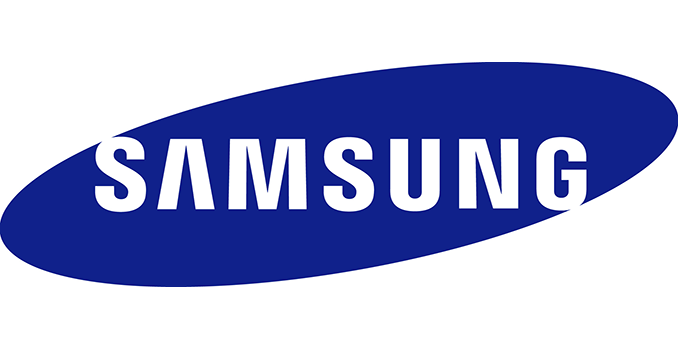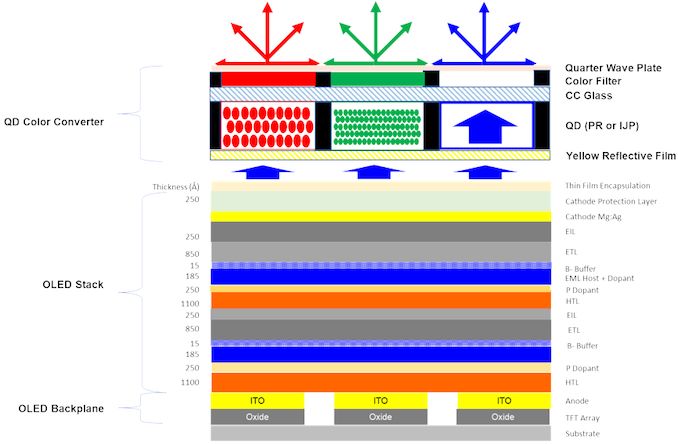Samsung to Invest $11 Billion in QD-OLED Panel Production
by Anton Shilov on October 15, 2019 5:30 PM EST
Samsung Display has announced plans to invest a further ₩13.1 trillion ($11 billion) in the R&D and production of QD-OLED TV panels. The plan includes building up two QD-OLED production lines in South Korea between now and 2025, with the first starting production in 2021. In addition, the company will invest in R&D of quantum dot-enhanced OLED technology, which promises to provide finer colors than today’s OLED displays and televisions.
The first step of Samsung’s QD-OLED plan will be converting its L8 fab in Tangjong, South Korea, from making LCD substrates to QD-OLED substrates. The plant is expected to produce 30 thousand QD-OLED substrates per month starting in Q1 2021. Longer term, Samsung will be converting all of its 8th Generation LCD production facilities to QD-OLED in a bid to increase the number of substrates produced monthly to 100 thousand.
The QD-OLED technology promises to simplify (i.e. lower the cost of) production of OLED-based televisions and monitors, as well as enabling wider color gamuts, which is something expected from next-generation content. Contemporary WOLED panels from LG Display use a blue or white (yellow + blue) OLED emitter stack, and a WRGB color filter system on top with a variety of additional layers behind, between, and ahead of them. By contrast, a QD-OLED panel uses an OLED emitter stack (some believe, with two emitting stacks) with a quantum dot RGB color filter (also called quantum dot color converter, or QDCC) system on top.
Today’s OLED panels feature 22 layers, whereas a QD-OLED panel may cut the number to 13, which means fewer deposition stages, lower material and production costs, and, perhaps, better yield. The QD-OLED technology is still considered to be rather challenging as Samsung has to solve light management issues. Meanwhile, according to Display Supply Chain, one square meter of an QD-OLED panel will cost around $26, whereas one square meter of a contemporary OLED panel costs approximately $95.
Lee Dong-hoon, CEO of Samsung Display, had the following to say:
"Quantum dots are semiconductor particles which luminate close to natural colors. It is the future growth vision of the large display industry. With the investment we will lead the premium display market."
Related Reading:
- Samsung Mulls Suspending South Korea LCD Plant Due to Oversupply
- Samsung Acquires Quantum Dot Tech Company QD Vision
- Samsung’s 8K QLED TV 55-Inch: A More Affordable 8K Ultra-HD TV
- 8K Association Sets Minimal Specs for 8K Ultra-HD TVs
- Sharp to Demonstrate 120-Inch 8K LCD TV & 8K TV with 5G Modem at IFA
- AU Optronics's New 85-Inch 8K LCD TV with 1,024-Zone Backlighting
- Samsung's 2019 QLED UHD TVs: 8K TVs Revamped, 4K TVs Get New Panel & Backlighting
Sources: Reuters, Nanosys, The Investor, Nikkei, DSCC, OLED-Info












42 Comments
View All Comments
Alistair - Tuesday, October 15, 2019 - link
Yeah as far as I understand it, this is basically WOLED from LG, but using quantum dot filtering instead of the more standard filtering that LG uses. Not sure it if will be better or worse, but at least we will finally have strong competition in the area in 2 years.wr3zzz - Tuesday, October 15, 2019 - link
From what I read elsewhere, it's not WOLED with QD filters. It's blue OLED using QD filters. Production savings is in using blue OLED instead of white, but using blue OLED also has more engineering challenges in producing colors.psychobriggsy - Wednesday, October 16, 2019 - link
At least with a single OLED colour emitter you will get even burn in. The old R/G/B OLED systems had different burn in rates for the different colours. Hence WOLED and similar display technologies for TVs that need to last 5-10 years, rather than the 2-3 years for mobile phones.Guspaz - Thursday, October 17, 2019 - link
The burn-in won’t be even between colours because the sub pixels are still dedicated to specific colours. You’d burn through your red sub pixels faster if you left CNN on all day long, for example.James5mith - Wednesday, October 16, 2019 - link
As long as they don't try to sell them as OLED TVs/Displays I'm fine with it.This is backlight technology, not panel technology.
nevcairiel - Wednesday, October 16, 2019 - link
Not sure where you are getting this, since there is no LCD layer or anything like that.Every pixel is individually driven by an OLED (or multiple OLEDs even for the sub-pixels), just like any old OLED display we have right now.
The entire concept is quite similar to what LG uses to make their OLED TVs today (single color OLEDs with color filters), just with a different implementation that promises better efficiency and cost-effectiveness.
Guspaz - Thursday, October 17, 2019 - link
They work almost exactly the same as every OLED television currently on the market. They still have the same advantages as an R/G/B OLED panel, only with a hit to power efficiency. Ultimately not a concern in a TV.peevee - Wednesday, October 16, 2019 - link
"with a quantum dot RGB color filter"It is certainly not a filter. You cannot just filter red light out of blue light.
"Quantum dot" term for this particular application is of course a marketing BS. The pixels are nowhere near the quantum sizes and it is the case of simple photoluminescence (not unlike cat piss under UV "black" light).
Guspaz - Thursday, October 17, 2019 - link
The term “quantum” in quantum dot refers to the particles themselves (as small as 2nm) and the way their optical properties differ from larger particles due to quantum effects. It’s not a marketing term (not originally, anyway, they’ve been called that since the 1980s) and not inaccurate.eastcoast_pete - Wednesday, October 16, 2019 - link
Key question for me is: will this prevent of strongly reduce the risk of burn-in. Burn-in is the key reason why I don't use an OLED screen as my main display. So, are the quantum dots alleviating that vulnerability?